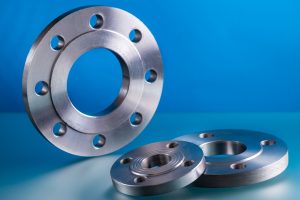
Talk to DS Pipe & Steel Supply to discuss the benefits of normalization of steel flanges and fittings.
When it comes to steel flanges and fittings, ensuring durability, strength, and reliability is essential. One key process that enhances these properties is normalization, a heat treatment method that refines the steel’s grain structure and relieves internal stresses. Normalization improves toughness and consistency by heating the steel above its critical temperature and allowing it to cool naturally in air, making it an ideal treatment for flanges and fittings used in demanding applications. Keep reading to discover more about the normalization of steel flanges and fittings, and contact the experts at DS Pipe & Steel Supply to determine if normalization is recommended for your project’s materials.
What is Normalization?
Normalization is a heat treatment process in which steel is heated to a temperature above its critical range (typically around 720-900°C or 1320-1796°F, depending on the steel’s composition) and then cooled in still air. This process refines the grain structure and improves the mechanical properties of the steel, making it more uniform, tougher, and stronger.
Why Normalize Steel Flanges and Fittings?
The normalization process ensures the reliability and durability of steel flanges and fittings used in critical applications. Here’s why it is done:
- Refines Grain Structure – Normalization improves the uniformity of the steel’s grain structure, enhancing its overall mechanical properties.
- Enhances Strength and Toughness – The process significantly improves the steel’s strength, toughness, and ductility, making it more resistant to stress and impact.
- Relieves Internal Stresses – During manufacturing, steel can develop internal stresses that may lead to structural weaknesses. Normalization helps to relieve these stresses, ensuring the material remains stable.
How is Normalization Done?
The normalization process involves three main steps:
- Heating – The steel is heated to a temperature above its critical range to ensure full transformation of its microstructure.
- Holding – The material is kept at this temperature for a specific duration, which varies based on composition and thickness.
- Cooling – The steel is allowed to cool naturally in still air, gradually returning to room temperature.
Applications of Normalized Steel Flanges and Fittings
Normalization of steel flanges and fittings is commonly performed in industries where high strength and durability are required. These applications include:
- Oil and Gas – Pipelines and pressure vessels operating under extreme conditions.
- Power Generation – Flanges and fittings in boilers and turbines.
- Petrochemical Industry – High-pressure piping systems.
- Structural Engineering – Load-bearing applications requiring enhanced toughness.
ASTM A105 vs. ASTM A105N: Understanding the Difference
Steel flanges and fittings are often classified under ASTM A105 and ASTM A105N standards:
- ASTM A105 refers to carbon and low-alloy steel forgings (including flanges and fittings) supplied in the “as forged” condition.
- ASTM A105N indicates that the steel has undergone normalization, leading to improved mechanical properties like increased strength and stress resistance.
- For critical applications, A105N is preferred due to the superior benefits of normalization.
Contact DS Pipe & Steel Supply Today for Steel Flanges and Fittings
When selecting the right steel flanges and fittings, trust the experts at DS Pipe & Steel Supply. Our knowledgeable team is ready to assist you with product selection, technical specifications, and fast delivery throughout Maryland, Washington DC., Virginia, and Delaware. Contact us today to discuss your needs and receive a competitive quote. In addition to submitting an online contact form, you may call us at 410-539-8000. Follow DS Pipe & Steel Supply on Facebook, X, and LinkedIn to stay informed of our company updates and services.









